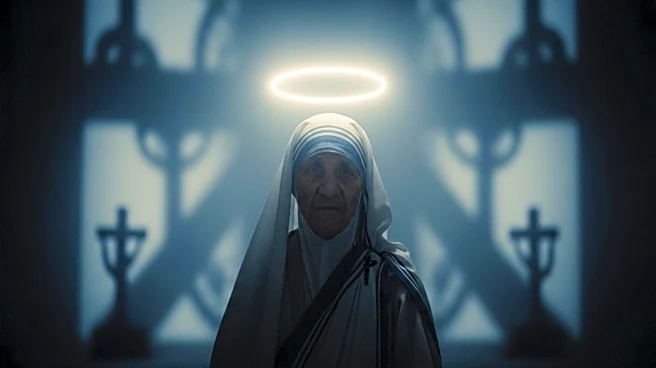What's Happening?
The film 'Mother,' directed by Teona Strugar Mitevska and starring Noomi Rapace as Mother Teresa, has garnered significant international interest following its premiere at the Venice Film Festival. The movie, set in Kolkata in 1948, explores seven critical days in the life of Mother Teresa as she seeks to establish a new religious order. The film has been sold to various international distributors, including Nour Films in France, Squareone in Germany and Austria, and Adler Entertainment in Italy, among others. Mitevska's portrayal of Mother Teresa challenges traditional saintly perceptions, presenting her as a complex figure with ambitions akin to a CEO.
Why It's Important?
The film's international sales highlight the global interest in stories that offer nuanced portrayals of historical figures, particularly women. By presenting Mother Teresa as a multifaceted character, the film encourages audiences to reconsider the narratives surrounding female saints and leaders. This approach may influence future biographical films, prompting filmmakers to explore the complexities of their subjects rather than adhering to conventional portrayals. The success of 'Mother' could also inspire more films that focus on the lesser-known aspects of influential women's lives, potentially leading to a broader representation of women in cinema.
What's Next?
As 'Mother' continues to attract international buyers, it is likely to reach a wide audience across various countries. The film's reception may spark discussions about the portrayal of religious figures in media and the balance between reverence and realism. Additionally, the film's success could pave the way for more projects that explore the lives of women in history, encouraging filmmakers to delve into the complexities of their characters. The film's distribution across multiple regions suggests a growing appetite for diverse narratives that challenge traditional storytelling.
Beyond the Headlines
The film's depiction of Mother Teresa as a 'CEO-like' figure raises questions about the intersection of ambition and spirituality. By demystifying the saintly image, the film invites viewers to consider the human aspects of revered figures, potentially influencing how society perceives leadership and ambition in religious contexts. This portrayal may also contribute to broader discussions about gender roles and expectations, particularly in positions of power and influence. The film's approach could inspire a reevaluation of how historical narratives are constructed and the importance of presenting a balanced view of influential figures.












